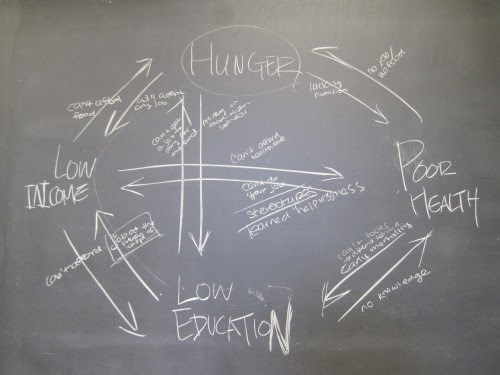The Paradox of Poverty
It has been said, primarily by privileged white men, that inequality does not exist. We are all equal in opportunity; racism, sexism, and classicism do not hinder a person’s ability to reach their dreams unless they let it. Also, that inequality is an excuse, and anyone can become anything here in America if they get off their lazy exploitative and put in the work. To some extent, that is the truth, and certain people have overcome the social issue of equality, a measly 4%. However, those people are the exception, and the exception makes the rule.
Inequality is the most critical social issue because it is an issue in and of itself, yet it leads to many other issues. Ending inequality is in the best interest of every American, even those at the top of the social hierarchy, and here is why; inequality is at the very roots of nearly every social issue: poverty, health issues, abortion, education, deviance, and crime to name a few.
Social inequality is the existence of unequal opportunities and rewards for different social positions or statuses within a group or society. Gender inequality refers to unequal treatment or perceptions of individuals wholly or partly due to their gender. Classicism is prejudiced against or in favor of people belonging to a social class, and structural inequality is a “condition” where one category of people has attributed an unequal status to other categories of people.
Institutional racism (a form of racism expressed in the practice of social and political institutions), sexism, classicism, and the bias intolerance deeply rooted in our social construct all have a significant role in inequality. Therefore if we could eliminate these issues, we could make giant leaps and bounds toward ending inequality.
Teenage pregnancy causes more children to be born into poverty, more people living off welfare, more people with a sub-par education, and more people who can only attain minimum wage jobs, equating with more people living in poverty. Teenage pregnancy can also lead to abortion, a massive social issue. Abortion can also lead to stigma, which can lead to deviance, leading to crime. Hence, teenage pregnancy is an issue enhanced by poverty, which creates additional poverty.
Rather than having the issue of teen pregnancy or abortion, imagine a society that requires birth control once puberty is reached, with the ability to reverse it, by an educated middle-class adult woman or a middle-class married family. There is a minimum income requirement before procreating, and each family must reach an income in fair proportion, an income to child ratio that would keep individuals in poverty from procreating until they have a financial parenting plan in place.
One in five marriages ends in divorce. African Americans are twice as likely to divorce than whites and Latinos due to economic hardships and stress that lead to a disruption in the marriage. 85% of children involved in divorce end up living with their mother. Women experience a dramatic decline in economic resources following a divorce, and as discussed previously, female householders make up 31.6% of families in poverty.
The rising cost of healthcare is affecting all of America. In 2010 2.6 trillion dollars was spent on healthcare, which is a little less than 1/8th of our National Deficit. Even with these high healthcare costs, the United States ranks a meager 47 in average life expectancy. Minimum wage jobs do not carry health insurance for their employees, leaving a disproportionately high number of Latinos and African Americans, and immigrants uninsured. Children of low-income families are at a higher risk for infant death, not having enough food, premature births, lack of adequate prenatal care, low birth weight, SIDS, and more are killing our ethnic children in America. Adult African Americans have a higher rate of heart disease, cancer, diabetes, dementia, and communicable disease.
African Americans suffer poor health due to the lack of education on healthy eating habits and routines, lack of healthcare as children, exposure to toxic wastes and other factors surrounding environmental racism, and the lead paint commonly found in older houses used for low-income housing. Poverty helps create poor health and helps maintain poor health. Poor health leads to the need for medical attention; the lack of insurance leads to large amounts of debt, and large amounts of debt place one into poverty. To improve healthcare, perhaps all the money we save on the incarceration of criminals, as discussed below, should be applied to a health care reform plan that mirrors Canada’s.
In 2010 17.4 Million Americans used marijuana at least once, and 4.6 million used it daily 1.2 million people reported using hallucinogens in the past few months, and 1.4 percent of high school students used methamphetamine in 2011, and these are just a few of the drugs available. Drug use is extremely high in the United States, and a combined racial background reportedly has the highest use of drugs at 12.5%. Drug use is considered deviant behavior, and there is a correlation between deviance and crime.
Deviance is the violation of the cultural norms or relatively unsuccessful socialization and is based more on the audience’s reaction to the subject’s first actions. Primary deviance is an action that has caught negative attention and creates a stigma for the person as a deviant, or the stigma turns this primary deviance into secondary deviance. Once this secondary deviance sets in, it becomes one’s identity, and crime is more likely to be committed by someone with this stigma. After their ” rehabilitation, the punished or convicted should not have that stigma after their “rehabilitation.” The person’s stigma carries on long after the end of a sentence.
Moreover, that shame is the second sentencing. Each convicted criminal should have the chance for successful re-socialization upon their “reintegration” with society. We can do so by allowing the rehabilitated to attach a new label to themselves; one may earn a new label by judicial systems allowing defendants to choose their punishment: to commit themselves to a facility such as a prison, a mental hospital, or a rehabilitation center. Alternatively, one may choose to serve our country or the community by becoming a soldier or a missionary. After the punishment or what we can call rehabilitation, society can now view a formerly convicted person positively.
The stresses of living in poverty tend to lead to drug use, and drug use leads to crime to support drug habits, criminal activity, and drugs have a secure connection. Poverty can lead to drug use, which can lead to crime; the impoverished committing crimes leads to many minorities in the criminal justice system; many of the people processed in the criminal justice system are poor, uneducated, unemployed, or working minimum wage jobs, i.e., people living in poverty.
People living in poverty are excessively Black and Hispanic, helping to support views of racism, which leads to a lack of change in institutionalized racism. Institutionalized racism leads to poverty.

